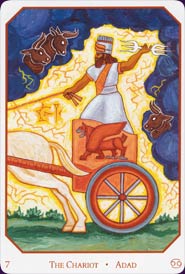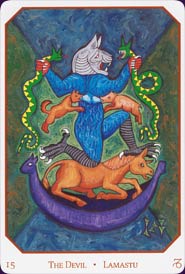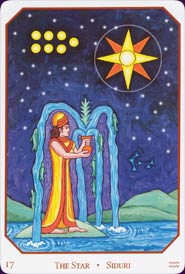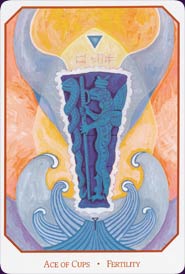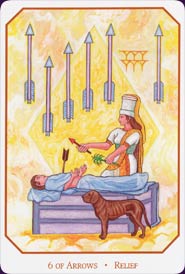Babylonian Tarot Deck Review

Creators: Sandra Cicero
Published: 2005
The Babylonian Tarot is a unique deck based on the cosmology and legends of the Ancient Sumerians, Mesopotamians and Babylonians, who lived more than 4000 years ago. There are 83 cards in this occult deck, including an extra major arcana card titled Genesis and another court card in each suit.
Retailers
This deck is rare or out of print and isn't easy to find. Search for it on eBay or Amazon.com, or browse our most popular Tarot decks.Babylonian Tarot Review by Bonnie Cehovet
The "Babylonian Tarot" is an 83 card deck that follows traditional lines, with the addition of five cards. The card "Genesis" has been added to the Major Arcana. It carries no number, and has no attribution. It represents time and space beyond words and number - the birth of the Universe. The card "Kerub" has been added to the court cards of each suit, and represents Spirit.
The four suits are Wands, Cups, Arrows (Swords) and Disks (Pentacles). The four court cards are Kerub, King, Queen, Prince (Knight) and Princess (Page). The structure of the Major Arcana remains the same, with the addition of Genesis. Strength carries the number eight, and Justice the number eleven.
This is the only deck that is based on the cosmology and legends of ancient Mesopotamia. The name of the deck comes from its primary city - Babylon. Babylonian culture - their way of life, style of writing, and religious customs, evolved through the Sumerian influence in the Mesopotamian valley. In working with this deck, we need to remember that the Babylonians were basically an agricultural people, and that their view of the relationship between gods and humans was very much that of parent to child. There existed an hierarchy of gods: cosmic gods, underworld gods, city gods, nature gods, and personal gods.
The companion book to this deck, "A Guide To The Babylonian Tarot", is very to the point. Cicero presents the historical background for the deck, and then presents the cards themselves. Her presentation is text only, without the use of scans. The God represented in each card is discussed, followed by upright and reversed meanings. While no "attribution" is given to Genesis, Cicero has included upright and reversed meanings.
In the section on card spreads, Cicero has developed two new spreads that are specific to this deck: "The Babylonian Universe Spread", which is a six card spread; and "The Rosette of the Gods Spread", which is a ten card spread. There are no sample readings given. There is an excellent Appendix giving esoteric correspondences for the Trumps, Pips, and Court Cards.
The cards themselves are 3 1/4" by 4 5/8", of high quality, sturdy, glossy card stock. The backs show a 1/2" blue border, with a lighter blue center. A winged, four-legged figure with a human head is shown on each end of the card, placed so that it would be impossible to tell if the card had been drawn in the upright or the reversed position.
The card face shows a 1/4" white border, followed by a slender red border. The Major Arcana title, followed by the god represented, is printed across the bottom of the card in gold lettering. The number and suit of the Pips are printed across the bottom of the card, in gold lettering, along with keywords for the card. The Court Cards show the title and suit printed across the bottom of the card in gold lettering, followed by the God represented.
The artwork in this deck is rather primitive, with an intense use of color. There is some nudity, which, while not inappropriate, would not make this an acceptable deck for use with children, and would have to be used with discretion with adult clients.
There were several cards that I felt drawn to, amongst which was Genesis - quite a thought provoking card. Cicero describes this card as portraying the birth of the universe and the generation of the primeval gods. The head of an ancient deity appears in profile in white at the top of the card. behind him we see a storm filled black sky with vibrant red lightening bolts. In the tumultuous sea below this we see a fetus, representing the first of the gods to be born. A dark card, indeed!
The keywords on the Four of Cups (Mixed Blessings) fascinated me, as they give the card a more positive feeling than it usually carries. The theme of this card was taken from the Babylonian epic "Erra and Eshum". The background of this card is a light blue. In the middle of the card, we see a golden egg shape. At the top of the egg we see the elderly god Marduk facing away from the reader, essentially turning his back on his past glories, and his greatest accomplishments. Four vessels are shown in the foreground: two fluted libation cups and two ceramic pots, signifying mixed blessings. In the center we see the cuneiform numeral two.
The Ace of Wands is shown in vibrant reds, yellows, greens and blues. The wand in the center of this card is the double-headed lion scepter that represents the Goddess Ishtar. The Wand is surrounded by an aura of flames in green, yellow and red. You know that there is power here!
As a professional Tarot reader, I like to see the card of Temperance come up. In this deck, we see Temperance as represented by the Tree of Life. The Tree is located in the center of a garden, in this instance with a winged disc above its apex. The background here is lavender and blue diamond shapes, bringing in a feeling of Spirit.
The Hanged Man is associated with the god Tammuz, a god representing growth and new life. He is also called the "divine shepherd" and the "bridegroom". In this card, we se an upright figure, dressed in white with his hands thrown up in surrender, with galla demons on either side of him, ready to take him into the underworld.
From here we go to the Three of Disks - a card of very gentle energy. The keyword for this card is "Work". In the lower half of the card we see the Goddess Uttu, hard at work. The symbol for the name "Uttu" was also used to mean spider. In the lower right hand side of the card we see a friendly looking spider - her sacred animal. At the top of the card we see three circles. In the top circle we see the graphic of a lion-fish. In the two circles below it we see the "goat-fish" symbol of Capricorn. Done in yellows, greens and blues, this would make a wonderful card to take into meditation.
The card of the Emperor, associated with the god Marduk, struck me as very funny. He is a god of thunder and tempest, and this card certainly exemplifies that energy. Marduk was also a gifted healer and magician. The predominate colors here are reds and yellows. Marduk is shown as a mature male, energetically striding off to battle. (He is striding to the left hand side of the card, which is the past, which is something to think about.) His feet are clad in golden sandals, and he wears a red robe, with his sword across his waist. In one hand he carries a lightening bolt, in the other his symbol of the "marru", or triangle-headed hoe. In the background we see a double set of golden wings.
I found this deck easy to work with, even without knowing the "story behind the story" (the story of the god depicted in each card). I would not recommend this deck for someone who is not familiar with the basics of Tarot, but as an additional reading deck, or for collectors, this would be a good deck to keep in mind.
Babylonian Tarot Review by Sheila Hamilton
This is an interesting deck with some unusual features. There are 83 cards instead of the usual 78; there is one extra card in the Major Arcana and 4 extra Court cards within the Minors. Arrows replace the more traditional Swords whilst Disks replace the Coins/Pentacles.
Sandra Tabatha Cicero, who both painted the images for the deck and wrote the handsome (though not unwieldy) companion book, is well known in magical circles. She is a Senior Adept in the Hermetic Order of the Golden Dawn, and has been involved in creating other Tarots, namely THE GOLDEN DAWN MAGICAL TAROT and THE GOLDEN DAWN ENOCHIAN SKRYING TAROT. Having tried the former of these several years ago, and having failed to "bond" with it, what made me pick up THE BABYLONIAN TAROT? Simply, it is much more based on mythological themes, in other words, the deities, demons, monsters and legends of ancient Babylon, widely considered to be the oldest civilization on Earth. I love mythology and mythology, springing as it does from archetypal experience, goes along very well with the Tarot, each enhancing the other. The Babylonian mythology is every bit as complex as the Greek, for example, and much less familiar. I won't remember all the gods overnight, nor the monsters with whom they do battle, but they are beautifully depicted on the cards (in a simple style based on ancient Babylonian images found in temples and so on)and described eloquently and never pompously in the book. Cicero is clearly steeped in the legends and landscapes she explores so well.
So, why the extra cards? The extra Major is Genesis, a powerful card aiming to evoke the primordial seas and mists out of which the gods themselves were born. Because it suggests a time even before the concept of "zero", it is not numbered. Cicero interprets it as "A new beginning. Commencement of a completely new outlook or phase of life." As for the 4 extra Court Cards, there is one for each suit and each of them depicts a Kerub. A Kerub is nothing like a Western cherub, though the words are clearly related. The Kerubim in ancient Babylon (which was a city; the surrounding area being known as Mesopotamia) were powerful spirits, generally protective but fierce if necessary. They were sometimes known as "the Sages and, according to ancient Babylonian belief, they existed even in the time before the Great Flood. In this Tarot deck they are: Lion-Headed Spirit (Wands), Eagle-Headed Spirit (Cups), Human-Headed Spirit (Arrows) and Human-Headed Bull (Disks). I thought at first that they would simply be an exaggerated form of the Ace card, in other words, embodying the essence of each suit. As such, I wondered if they were really necessary. After consideration, I came to the belief that they are. Cicero has them function in a more powerful and rather different way to the Aces-the Kerub of Cups, for example, means "Love of the Divine. Spiritual love and purity." I find these cards some of the most striking, visually-speaking, of any in the entire deck ; carved as enormous statues at the entrance of temples, they must have been awe-inspiring indeed. It would be a moving experience, I believe, to draw a Kerub in a reading.
Do I have any criticisms? Not really. I find the 6 of Cups rather lacking in the sense of childhood and nostalgia that the 6 of Cups usually carries; it depicts two people drinking what is presumably wine, and also two lovers (naked but not graphic). Nothing wrong with it, of course, just not quite what I was expecting. But Cicero's knowledge of Tarot iconography is second-to-none and I didn't expect to find, nor did I, any "gaffes."
This deck would appeal, I believe, to various sorts of people. I know little of the Golden Dawn tradition but I presume its enthusiasts will be drawn to this deck because of its creator. Anyone who likes mythology and finds it a helpful approach to Tarot will, like me, find this deck a real treasure. The cards are tastefully painted and not cluttered. It is not a deck specifically designed for children, and the book is in places rather sophisticated (though never downright obscure) but I think the older child could certainly use this deck with benefit. If you totally hate borders in any form, you will probably reject this deck (they are simple white borders; personally, I find them unobtrusive), and people who similarly hate keywords won't be entirely happy, either. But it is a well-considered and wise Tarot which should have a broad appeal.
Babylonian Tarot Review by Solandia
The Babylonian Tarot is the third deck from Sandra Tabatha Cicero, a senior adept of the Hermetic Order of the Golden Dawn. Her first two collaborations were the Golden Dawn Magical Tarot and the Golden Dawn Enochian Skrying Tarot, while her latest deck is the first to be based on the deities, legends and magical symbolism of ancient Babylon. In Sandra’s view, Babylon lies at the very foundation of the magickal tradition.
"The Babylonians provided us with humanity’s earliest written records of social, intellectual, and religious expression. Theirs was a long and rich history of human innovation and advancement, progress and set-backs, hopes and fears, successes and dreams. It is this rich source of knowledge that inspired the creation of Babylonian Tarot, correlating many of the major deities and legends of Mesopotamia to the wisdom of the tarot."
Babylon was an ancient city built in Mesopotamia, the 'Fertile Crescent', in what we now know as the Middle East. It was one of the oldest cities of man, dating back to more than 4000 years ago. The Mesopotamians were a deeply religious people, the practice of magic playing an important role in their religious expression, and are perhaps best remembered for their experimentation with one of the earliest known systems of writing - cuneiform, wedge-shaped marks pressed into clay. Elements of their mythology that have survived and been passed down through later religions for thousands of years.
The full deck of the Babylonian Tarot has 83 cards: 23 trumps and 60 minors. The extra card in the trumps is ‘Genesis’ and is un-numbered and stands for the absolute beginning or starting point. The other 22 trumps are illustrated with a Babylonian deity: Marduk as the Emperor; Ereshkigal, the ‘Queen of the Great Below’ as Death; the Hanged Man is illustrated by the god Tammuz; Gilgamesh, said to have built the walls of the city of Uruk, is Strength.
The suits of the minor arcana are Wands, Cups, Arrows (Swords) and Disks (Pentacles) and each have an extra card in the form of Kerub, the court card linked with Spirit. The cards occasionally suggest certain Thoth or Rider-Waite images, but the minor arcana imagery is mostly unique to this deck. Unlike some Golden Dawn decks that have pip-style cards in the minor arcana, here the suit scenes are generally of Babylonian life illustrated in a formalised style, with the suit symbols arranged over and around the card.
The companion book of 190 pages is quite obviously designed for a reader already very familiar with Tarot cards. There is a brief introduction to the deck from Sandra Cicero on Babylon and the deck’s design, followed by the card meanings. This section has a description of the deity or scenes in reference to Babylonian myth and history, followed by keyword meanings (no card image, however). While the information on each card is fairly succinct, a lot is packed into the space.
There are also two original spreads in the book; Babylonian Universe, a six card spread, and Rosette of the Gods, a ten-card spread. The appendix holds the trump, pip and court card correspondences and charts, and finally a bibliography for further reading on the ancient culture.
I knew very little about the Babylonian world before working with this deck, and I found doing a spread and using the companion book for more information on the symbolism, an effective way of learning about the Babylonian myths, deities, beliefs and culture. I would recommend this deck for the occult student with an interest in ancient history and civilisations, or for the more experienced reader looking for something new that still has a sound background in Western ceremonial magick.
Complete Details of Babylonian Tarot
Creators: Sandra CiceroPublisher: Llewellyn 2005
Deck Type: Tarot Deck
Cards: 83
Major Arcana: 23
Minor Arcana: 60
Deck Tradition: Crowley Thoth
Minor Arcana Style: Pips with Small Scenes
Suits: Cups, Arrows, Wands, Disks
Court Cards: Princess, Prince, Queen, King, Kerub
Major Titles: The Fool - Enkidu, The Magician - Ea, The High Priestess - Ishtar, The Empress - Aruru, The Emperor - Marduk, The Hierophant - Naba, The Lovers - Ishtar and Tammuz, The Chariot - Adad, Strength - Gilgamesh, The Hermit - Anu, The Wheel - Tablet of Destiny, Justice - Nanshe, The Hanged Man - Tammuz, Death - Ereshkigal, Temperance - Tree of Life, The Devil - Lamastu, The Tower - Marduk and Tiamat, The Star - Siduri, The Moon - Sin, The Sun - Shamash, Judgement - Etana and the Eagle, The World - Anki
The Fool is 0
Strength is 8
Justice is 11
Card Size: 3.19 x 4.61 in. = 8.10cm x 11.70cm
Card Language: English
Card Back: Reversible
Back Design: A black and white, winged, human headed bull stands facing left at both ends over a light blue background with a slightly darker blue border.
Companion Material: The book has a four-page overview of Babylonian cosmology and civilisation, a discussion of most cards and the myth used to illustrate them at length (some are a little brief), and upright and basic reversed meanings. The 7-page appendix gives correspondences for the trumps, pips and courts. Pip cards have keywords, mostly identical to those of the Thoth Tarot.
Rating: 18/20 or
Similar Decks to Babylonian Tarot
Theme: Historical, OccultCategory: Tarot Decks With Extra Major Arcana
Creator: Golden Dawn Enochian Skrying Tarot, Golden Dawn Magical Tarot by Sandra Cicero
< Previous Deck · Back to Top · Next Deck >
Home > Tarot Reviews > Babylonian Tarot Review

